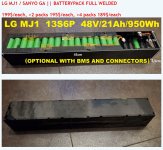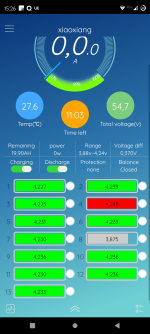bruno_mac_douglas
1 mW
- Joined
- Feb 20, 2020
- Messages
- 13
Hello!
I have a problem on my ebike: one cells seems not working correctly.
It gets quickly discharged to 0v and does not charge to full 4.2V.
When the other cells are charging this one charge lower.
I have a bluetooth BMS so I can have a good idea of it real time.
It can makes my battery fail and engine not starting when plenty of battery is still there on other cells.
Here are some screenshot and a video.
The bms is https://fr.aliexpress.com/item/4000316595074.html?spm=a2g0o.order_list.0.0.47c45e5bosC6MO&gatewayAdapt=glo2fra
The battery is a LG MJ1 / SANYO GA || BATTERYPACK FULL WELDED bought here:



when charging, BMS app shows this: https://www.youtube.com/watch?v=-R9HoEFA-OA
My question is: is the fault the battery (I think so but not 100% sure) or the BMS ?
The battery does not have many cycles done, so does the BMS.
Thanks in advance.
I have a problem on my ebike: one cells seems not working correctly.
It gets quickly discharged to 0v and does not charge to full 4.2V.
When the other cells are charging this one charge lower.
I have a bluetooth BMS so I can have a good idea of it real time.
It can makes my battery fail and engine not starting when plenty of battery is still there on other cells.
Here are some screenshot and a video.
The bms is https://fr.aliexpress.com/item/4000316595074.html?spm=a2g0o.order_list.0.0.47c45e5bosC6MO&gatewayAdapt=glo2fra
The battery is a LG MJ1 / SANYO GA || BATTERYPACK FULL WELDED bought here:



when charging, BMS app shows this: https://www.youtube.com/watch?v=-R9HoEFA-OA
My question is: is the fault the battery (I think so but not 100% sure) or the BMS ?
The battery does not have many cycles done, so does the BMS.
Thanks in advance.

